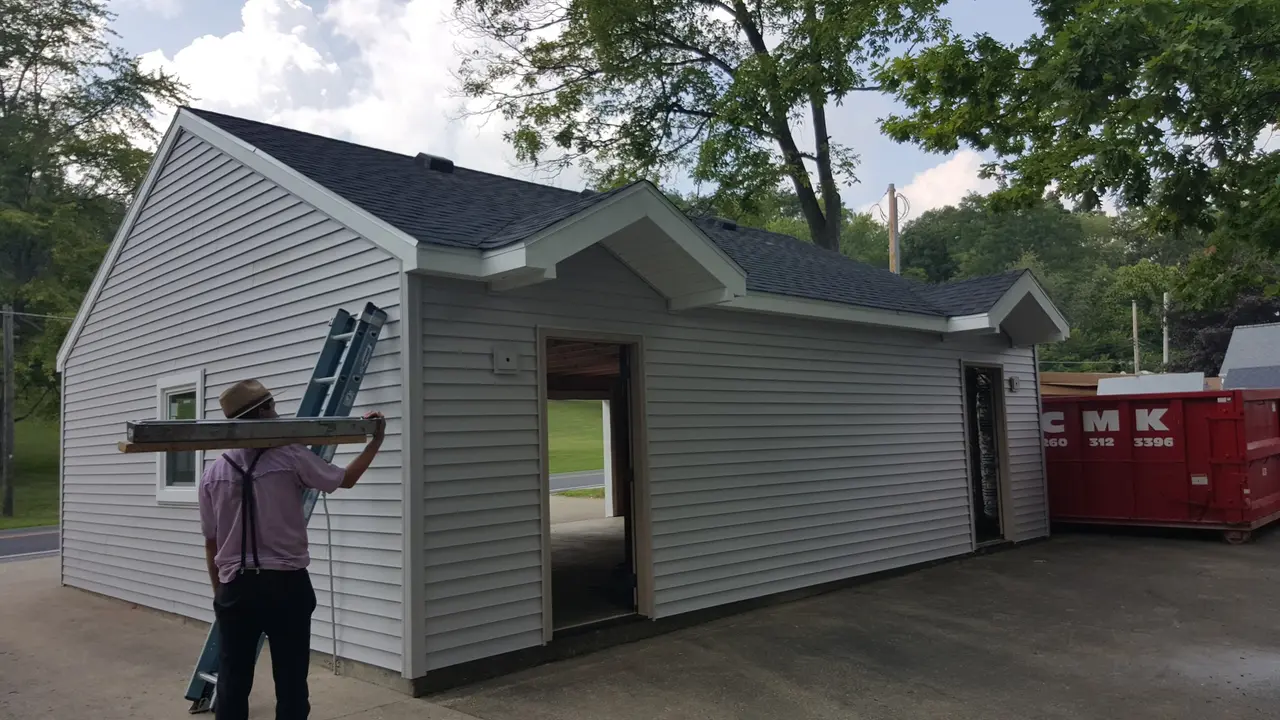SERVING FORT WAYNE AND SURROUNDING AREA

News & Insights

10 Essential Tips for Maintaining Your Vinyl Siding
10 Essential Tips for Maintaining Your Vinyl Siding
Vinyl siding is a popular choice for homeowners due to its durability and low maintenance needs, but it still requires a bit of care to keep it looking fresh and new. Keep reading to learn the essential tips that can help you maintain your vinyl siding, ensuring it lasts for years to come. Whether you’re a seasoned pro or a first-time homeowner, these tips are easy to follow and will help you protect your investment.

1. Regular Cleaning for Lasting Shine
One of the most critical steps in maintaining your vinyl siding is regular cleaning. Dust, dirt, and other debris can accumulate on the surface over time, leading to an unsightly appearance and potential long-term damage. To prevent this buildup, it’s advisable to clean your siding at least once a year. A simple approach is to use a mixture of mild soap and water, applied with a soft-bristle brush or a cloth. This method is effective and won't damage the siding, ensuring it retains its shine.
Additionally, power washing your vinyl siding can be a highly effective cleaning method, especially for more stubborn stains or mold. When using a power washer, it's essential to maintain a safe distance to avoid causing damage. Ideally, you should aim for a pressure between 1,500 to 2,500 PSI. This will help you lift away dirt without harming the surface. After cleaning, take a moment to inspect the siding; if you notice areas that need more attention, a second pass with a brush may be necessary.
2. Inspecting for Damage and Issues
Regular inspections of your vinyl siding are crucial for catching any damage before it worsens. Look for cracks, loose panels, or areas where the siding seems to be warping. If you live in an area with extreme weather conditions, such as heavy winds or hail, it’s especially important to check for potential issues after storms. Making it a habit to inspect your siding at least twice a year can save you from costly repairs down the line.
While inspecting your siding, pay special attention to the seams and corners. These areas can often be the first to show signs of wear. If you discover any problems, address them promptly. For instance, a small crack can often be repaired using a vinyl siding patch kit, which is available at most home improvement stores. Failing to address minor issues can lead to more significant problems, including water infiltration and mold growth.
3. Choosing the Right Cleaning Solutions
When it comes to cleaning solutions for your vinyl siding, opting for mild and non-abrasive products is essential. Harsh chemicals can strip away the protective coating on the siding, leading to fading or discoloration. Instead of bleach, try using a mixture of vinegar and water, which is gentle yet effective against mildew and other stains. Just mix one part vinegar with four parts water, apply it to the affected areas, and rinse off after a few minutes.
Keep in mind that not all commercial cleaning products are suitable for vinyl siding. Before purchasing any solution, check the labels to ensure they are safe for use on vinyl. Many products are specifically designed for cleaning siding, so look for ones that boast effectiveness against dirt and mildew while being easy on the material. Remember, a good cleaning routine combined with the right products can help extend the life of your siding.
4. Dealing with Mold and Mildew
Mold and mildew can be a persistent problem for vinyl siding, especially in humid climates. If left untreated, these growths can not only mar the appearance of your home but also lead to health issues. Detecting mold and mildew early is crucial. An easy way to tell if your siding is affected is to look for dark patches or spots, which are often signs of mildew. To remove it, scrub the affected area with a soft brush and your chosen cleaning solution.
In cases of severe mold infestation, you may need to use a stronger solution, such as a bleach mixture (make sure it's diluted correctly). However, always test a small, inconspicuous area before applying it to the entire region to ensure it won't damage the surface. Protecting surrounding plants and surfaces with tarps or plastic sheeting is also a good idea when tackling larger areas.
5. Handling Scratches and Dents
Accidents can happen, and scratches or dents on your vinyl siding can occur for various reasons, such as impacts from lawn equipment or extreme weather. Luckily, handling these imperfections is often straightforward. For minor scratches, try using a vinyl siding repair kit, which usually includes color-matching compound that can fill in the scratch and blend seamlessly with the surrounding area.
For more significant dents, you might need to replace an entire panel, especially if it affects the siding's structure or insulation properties. Most home improvement stores have replacement panels in various colors to match your siding. If you're unsure how to replace it, many online tutorials can guide you through the process step-by-step, making it more accessible for DIY enthusiasts.
6. Preparing for Seasonal Changes
As the seasons change, it's vital to prepare your vinyl siding accordingly to minimize weather-related wear. Before winter sets in, make sure to clean the siding and check for any damage that could worsen with snow and ice. Insulating your home may also help protect your siding from cold temperatures, minimizing the chances of cracks forming. On the flip side, during the summer, ensure proper ventilation around your siding to prevent heat buildup, which can warp panels.
In the spring, take a moment to inspect your siding for any damage caused during the harsh winter months. After heavy winds or damaging storms, check for loose panels or debris that may have accumulated. Being proactive during these seasonal transitions can help you keep your vinyl siding looking its best year-round.
7. Maintaining Your Gutters and Downspouts
Your composite siding’s cleanliness and integrity are heavily influenced by the health of your gutters and downspouts. When these systems are clogged with leaves and debris, water can overspill and run down the sides of your home, causing stains and even mold growth. Therefore, regular cleaning and maintenance of your gutters are essential. Aim to do this at least twice a year, particularly during the fall when leaves are likely to accumulate.
Additionally, ensure that your downspouts direct water away from the foundation of your home. Water that pools too close can lead to various issues, including foundation cracks and excess moisture around your siding. If you have noticed standing water or signs of drainage problems, consider extending your downspouts or consulting a professional plumber to rectify the issue.
8. Understanding Siding Colors and Fading
Vinyl siding comes in a variety of colors that can enhance your home's curb appeal. However, exposure to UV rays over time can lead to fading. Understanding how to maintain the color of your siding is crucial. One effective way is to choose high-quality vinyl siding that is specifically designed to resist fading. Many manufacturers now offer warranties on their products that resist color change, which is an excellent investment for long-term maintenance.
Regular cleaning of your siding can help reduce fading. When dirt and grime accumulate, they can create a layer that darkens the color, making it look faded. By keeping your siding clean and inspecting for any discoloration, you can take corrective actions sooner, such as repainting or applying protective coatings that help preserve the original hue.
9. When to Call a Professional
While many vinyl siding maintenance tasks can be performed by homeowners, there are times when it may be best to call in a professional. If you notice extensive damage that requires replacing multiple panels or significant structural issues, seeking a qualified contractor is wise. Professionals have the expertise and tools necessary to handle these repairs safely and effectively.
If you're uncomfortable performing certain maintenance tasks, such as power washing or inspecting the roof, don't hesitate to enlist help. An experienced contractor can do a thorough inspection and provide a detailed report on the health of your siding and any needed repairs. This will not only save you time but can also save you money in the long run by preventing small issues from turning into much bigger ones.
10. Investing in Vinyl Siding Accessories
Finally, consider investing in accessories designed specifically for vinyl siding maintenance. From protective coatings that prevent fading to decorative accessories that add character to your home, these additions can prolong the life of your siding and enhance its appearance. For example, purchasing drip edges can help protect your siding from water runoff, while shutters can not only provide visual appeal but also protect the siding underneath.
Roof overhangs and awnings can offer added protection to your siding by reducing direct exposure to harsh weather elements. By investing in these accessories, you not only improve your home’s aesthetic but also ensure that your vinyl siding is safeguarded, saving you from costly repairs in the long run.
Protect Your Home's Curb Appeal! Regular maintenance can keep your vinyl siding looking brand new for years to come. Contact us if you have questions about installing or the maintenance of vinyl siding.
Get Your Free Estimate Now and Start Transforming Your Space Today!
